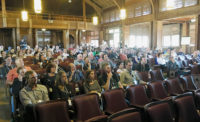2017 AIA Conference: Architects Talk Socially Conscious Design

Alejandro Aravena delivered a classroom-style lecture on how to anticipate housing needs in a rapidly urbanizing world.
Photo © Architectural Record/Anna Fixsen

The Pritzker laureate scribbled facts and figures on a white board explaining how to maximize the benefits of public housing amid spatial and political constraints.
Photo © Architectural Record/Anna Fixsen

Berlin-based architect, Diébédo Francis Kéré, explained how he uses local materials and labor to build in his native Burkina Faso.
Photo © Architectural Record/Anna Fixsen

Diébédo Francis Kéré
Photo © Architectural Record/Anna Fixsen

Michael Murphy of MASS Design Group
Photo © Architectural Record/Anna Fixsen

Murphy showed a design for a Holocaust memorial in London, the centerpiece of which is a pile of 6 million engraved stones that visitors are encouraged to take home.
Photo © Architectural Record/Anna Fixsen

Diller Scofido + Renfro’s Elizabeth Diller spoke about working within the legacy of Jane Jacobs, as well as the successes and shortcomings of the High Line.
Photo © Architectural Record/Anna Fixsen

Robert A. M. Stern received the Topaz Medallion for Architectural Education in honor of his decades-long legacy at Yale.
Photo © Architectural Record/Anna Fixsen








“The making of architecture is best taught by example,” said Robert A. M. Stern today, as he accepted the 2017 AIA Topaz Medallion at the national conference in Orlando. “Architecture education should also prepare students to positively affect the lives of others.”
Indeed, all of this morning’s keynote speakers demonstrated the ways in which architects and designers can become leaders and agents for positive change in the world through their work.
The first speaker, Diébédo Francis Kéré, highlighted the importance of using local materials and labor, citing several of his school projects throughout his home country of Burkina Faso. “I grew up in the classroom where you could put your hand up and touch corrugated iron, which is not a good solution where temperatures can reach 60 degrees Celsius [140 degrees Fahrenheit],” he said, “Here we have a new ceiling made of clay bricks that I taught people to make out of the material we have in the village.” Through his work and his words, Kéré also emphasized the value of education. “Access to knowledge remains something unreachable for many kids in Africa,” he said. “That is what is splitting us.”
Likewise, Michael Murphy of Boston-based MASS Design Group spoke to the ability of design to unite, beginning his talk with an anecdote about infamous architect Albert Speer’s choice to locate Nazi labor camps adjacent to rock quarries, and closing with MASS’s proposal for a Holocaust memorial in London. The structure would center around a pile of 6 million stones—including 4 million inscribed with the names of those who died—taken from the very quarries Speer exploited. “We will invite visitors to take one of the stones and choose to participate in the fight against intolerance,” he said. “What remains is a space of hope.”
Elizabeth Diller, founding partner of Diller Scofidio + Renfro in New York, spoke about her interest in applying activist and urbanist Jane Jacobs’ principals to contemporary public projects. Diller went on to reflect on her firm’s most visible, and most popular, project through a Jacobian lens: The High Line—which saw 7.6 million visitors in 2016 and has generated $5 billion in real estate investment, 12,000 jobs, and 33 new major development projects—is predicted to generate $1 billion in tax revenue for New York City over the course of 20 years. She noted that while these metrics indicate it has been a smash success in terms of community revitalization, that same success has led to skyrocketing rents in the surrounding buildings, which have decreased the area’s demographic diversity.
Looking toward her firm’s next major project in Manhattan—a flexible cultural center called the Shed—she ended with a word of advice about designing in anticipation of the future. “Architects can change the agency of the discipline entirely and become activists as Jane Jacobs,” she said, “not necessarily defending something that was always in there, but producing something totally new.”
Stationed in front of a whiteboard, Pritzker prize–winner Alejandro Aravena also addressed principals of forward-looking architecture, which form the foundation of his strategy for “incremental social housing” in his native Chile. Working on a shoestring budget from the government, his firm’s design for “half a house” allows families to expand their living spaces over time, as resources allow. Most can complete a home for a total investment of less than $2,000, and the architect reported that he’s heard anecdotes of families building out and eventually selling their homes for as much as for $75,000—a life changing sum.
“We should be able to engage in issues that interest the society at large,” Aravena concluded.
Read more of RECORD’s coverage from the 2017 AIA conference.












